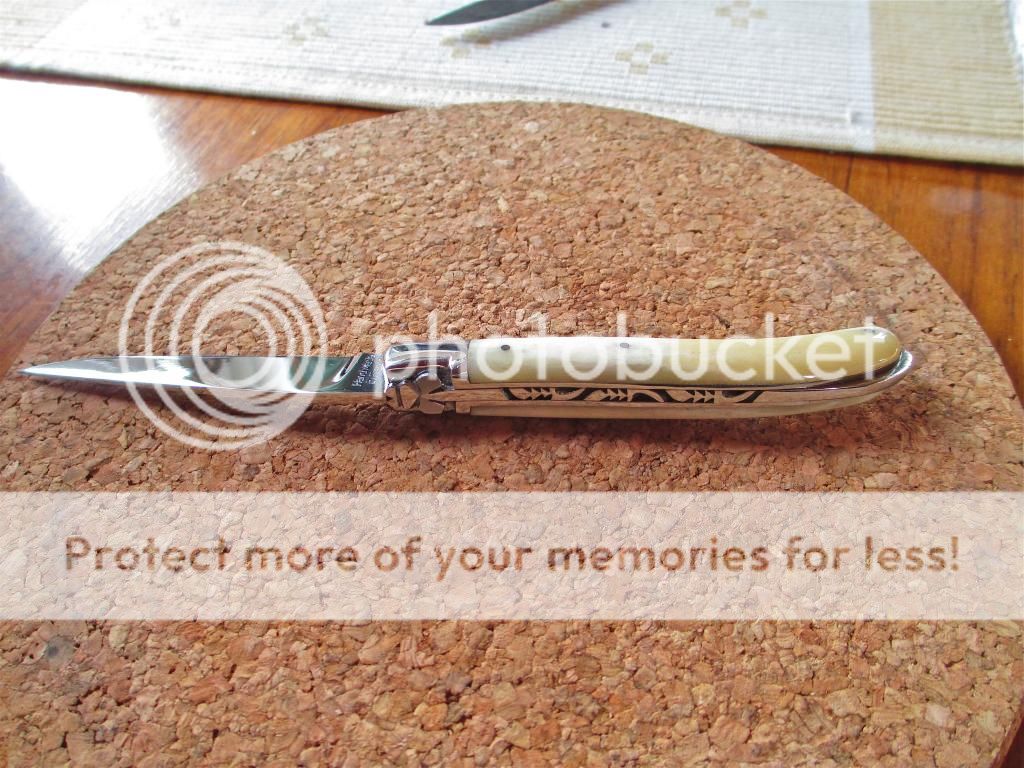A Quick history
The Laguiole knife was started in 1828, derived, influenced from various sources. The ancestors of the Laguiole knife were called Capuchadou. Farmers in Aveyron used this course dagger to cut bread or wood in the middle of the 19th century. It was composed of a thin fixed blade and a short wooden handle. Another inspirations believed to have come from the Spanish Navaja. The farmers used to cross into the Pyrenees Mountains to go and work in Catatonia fro the summer with their long saws since fieldwork did not require more hands at home. They probably brought back this Spanish knife, with its ring-like safety locks and its Turkish style blade yatagan like seen on the Opinel.

Laguiole, besides being the name of a village in Aveyron and cheese, is a generic pattern name, like stockman, congress, trapper etc. Besides, the name has never been patented and is not protected in any way. The lack of legal protection of the name results in low quality knockoffs from Pakistan, China, Japan and Mexico . There are two main cutlery hubs, in France, the city of Thiers France, where a total of about 70-80 companies produce Laguiole knives from craftsmen producing handmade products to larger industrial type establishments producing more of a mass produced product, soldered fly/bee and stamped patterns in the spring opposed to filed and chiseled, and then the village of Laguiole in Aveyron, where a handful of smiths and craftsmen produce the knives. This is where the original Calmels shop owned by G. Arbalete David, is located.
This is a Rossingnol from Thiers under $100, great knife but more mass produced, the notches on this blade represents the days of the week

Laguiole knife evolved from a single blade to a two and three piece tool the first addition was the poincon, the piercer that was used to make holes in the horse harnesses or to pierce the paunch of sheep suffering from colic, bloating from eating grass, to remove pebbles like a hoof pick out of horse’s shoes, The corkscrew was added around 1880 when some farmers from Aveyron left the farm life and moved to Paris to try to make a living in another way.
Everything I've read says, claims, Aveyron born Jaques Calmels, son of an innkeeper from Laguiole village who invented the knife after an apprenticeship in cutlery production. The Laguiole knife replaced the Capuchadou proved to be really handy and convenient for the farmers.
While there is absolutely nothing wrong with Forge De Laguiole, they are a new comer and actually opened their doors in 1987, also they make different tiers of level quality,( many makers do this, so do your homework ) some are mass produced versions in the $79-$100 range, mostly sold to the US market, and others super high quality $180,$200 and up dollar range, yes they are French made, and setup shop in the town of Laguiole, their bee/fly is soldiered onto spring rather than a one piece forged spring and bee/fly on the lower end models, I say lower end but they are still a extraordinary knife. For a few dollars more take a look at Laguiole En Aubrac, one person/cutler makes the knife from start to finish and signs the back of blade with a specific file pattern, also the spring & fly/bee is forged from one piece of steel and the file marks are more pronounced and unique done by hand, Laguiole En Aubrac was found in the hands of most farmers and on the vineyards in France when I was there. Be carful when buying Laguiole as it is a style like stockman, congress, trapper etc. lots of junk ones on the market.


Can't stress enough that there is nothing wrong with Forge De Laguiole, I will probably add one to my stable at some point, just do your homework and know what you are actually buying.
Although ornate these are rugged work knives, used mine for carpentry and solo camping trips, and I can only speak of mine which are in the 15-20 year old range and don't know about newer ones they are not for the weak, if you think older GEC's are bear traps and a pull of 10 then these are elephant traps at a pull of 15-18 so be warned, also older ones like mine lack a kick so part of the blade rest on the spring but I believe all the newer ones are now made with kicks.
I will PM you a reputable distributor
Pete








